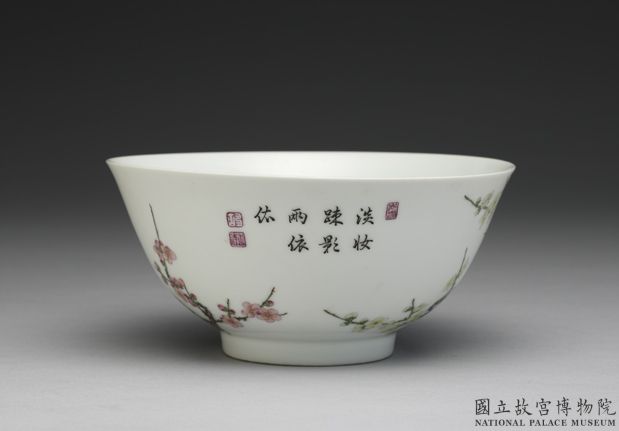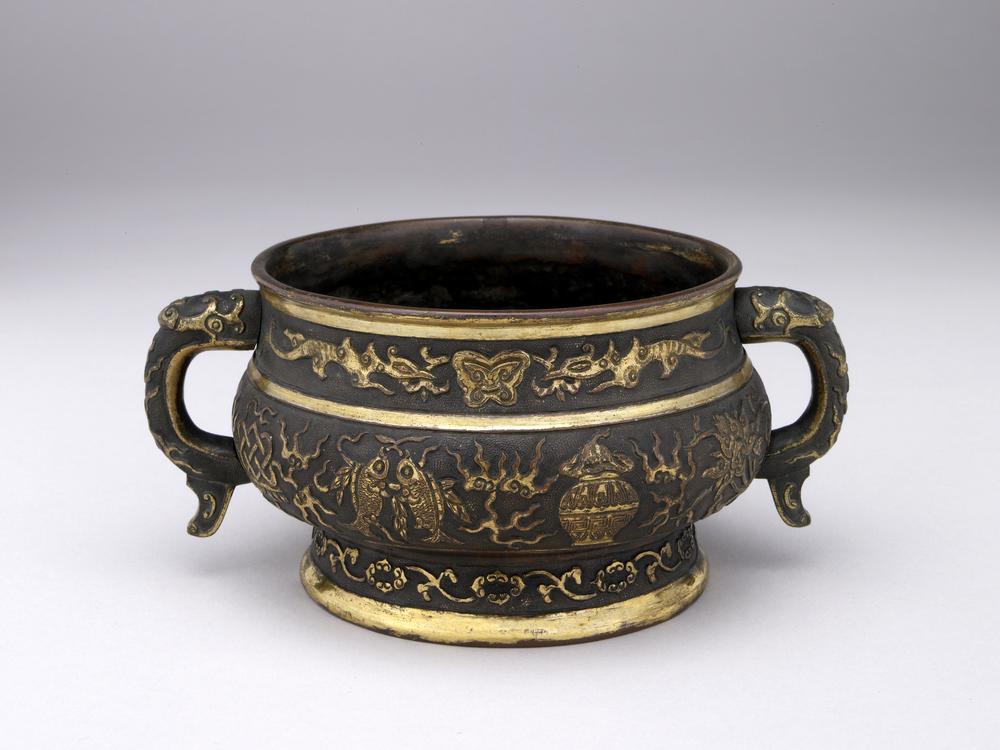Period:Ming dynasty Production date:1628-1644 (circa)
Materials:porcelain
Technique:glazed, underglazed,
Subjects:landscape lotus arhat
Dimensions:Diameter: 16 centimetres Height: 8.20 centimetres
Description:
Porcelain bowl with underglaze blue decoration. This blue-and-white bowl has deep rounded sides, flared at the rim, and a ‘bi’-disc unglazed foot ring. Inside in the centre is a single lotus and a wheel of the law, surrounded by a band of five lotus heads on a dense scrolling ground. Encircling this, connected by double stems, is a ring of alternating lotus blooms and buds. Above are six Chinese characters separated by wheels of the law and with a ‘ruyi’-head border at the rim. Outside are five Luohan in a landscape, identified by the auras of light around their heads. The first Luohan is seated beneath a willow tree on a carpet of flowers, holding a rosary in his right hand; he appears to be looking at a sinewy dragon which is emerging from the clouds above. Bodhidharma, the legendary founder of Chan Buddhism, is painted with his characteristic thick beard and bushy eyebrows crossing the river standing on a reed. Just in front of him is a Luohan holding a begging bowl and standing on the back of a giant crab, moving sideways through the water. On the bank, the Tiger Tamer Luohan is standing with his tiger and stares at another Luohan standing on a giant conch shell.
IMG
![图片[1]-bowl BM-1928-0522.6-China Archive](https://chinaarchive.net/Ming dynasty/Ceramics/mid_00253363_001.jpg)
Comments:Harrison-Hall 2001:Bodhidharma is said to have performed the feat of the river-crossing during the reign of Emperor Wu of the Liang (AD 502-49). Luohan are disciples of the Buddha, known as ‘arhats’ in Sanskrit. They have passed through all the stages of the Path to Enlightenment but remain in the mortal realm as holy figures, rather than attaining Nirvana and Buddhahood, in order to help others and uphold Buddhist doctrine. As with Christian saints, for example St Peter and the keys, each has their own attribute, name and qualities. Generally paintings and sculptures of Luohan were made in series of sixteen or eighteen. Interestingly even in China they have Indian-style features. For an example of a Yuan painting of the thirteenth Luohan, Ingada, dated 1345, in the British Museum see Farrer 1990, cat. no. 45.
Materials:porcelain
Technique:glazed, underglazed,
Subjects:landscape lotus arhat
Dimensions:Diameter: 16 centimetres Height: 8.20 centimetres
Description:
Porcelain bowl with underglaze blue decoration. This blue-and-white bowl has deep rounded sides, flared at the rim, and a ‘bi’-disc unglazed foot ring. Inside in the centre is a single lotus and a wheel of the law, surrounded by a band of five lotus heads on a dense scrolling ground. Encircling this, connected by double stems, is a ring of alternating lotus blooms and buds. Above are six Chinese characters separated by wheels of the law and with a ‘ruyi’-head border at the rim. Outside are five Luohan in a landscape, identified by the auras of light around their heads. The first Luohan is seated beneath a willow tree on a carpet of flowers, holding a rosary in his right hand; he appears to be looking at a sinewy dragon which is emerging from the clouds above. Bodhidharma, the legendary founder of Chan Buddhism, is painted with his characteristic thick beard and bushy eyebrows crossing the river standing on a reed. Just in front of him is a Luohan holding a begging bowl and standing on the back of a giant crab, moving sideways through the water. On the bank, the Tiger Tamer Luohan is standing with his tiger and stares at another Luohan standing on a giant conch shell.
IMG
![图片[1]-bowl BM-1928-0522.6-China Archive](https://chinaarchive.net/Ming dynasty/Ceramics/mid_00253363_001.jpg)
Comments:Harrison-Hall 2001:Bodhidharma is said to have performed the feat of the river-crossing during the reign of Emperor Wu of the Liang (AD 502-49). Luohan are disciples of the Buddha, known as ‘arhats’ in Sanskrit. They have passed through all the stages of the Path to Enlightenment but remain in the mortal realm as holy figures, rather than attaining Nirvana and Buddhahood, in order to help others and uphold Buddhist doctrine. As with Christian saints, for example St Peter and the keys, each has their own attribute, name and qualities. Generally paintings and sculptures of Luohan were made in series of sixteen or eighteen. Interestingly even in China they have Indian-style features. For an example of a Yuan painting of the thirteenth Luohan, Ingada, dated 1345, in the British Museum see Farrer 1990, cat. no. 45.
© Copyright
The copyright of the article belongs to the author, please keep the original link for reprinting.
THE END





